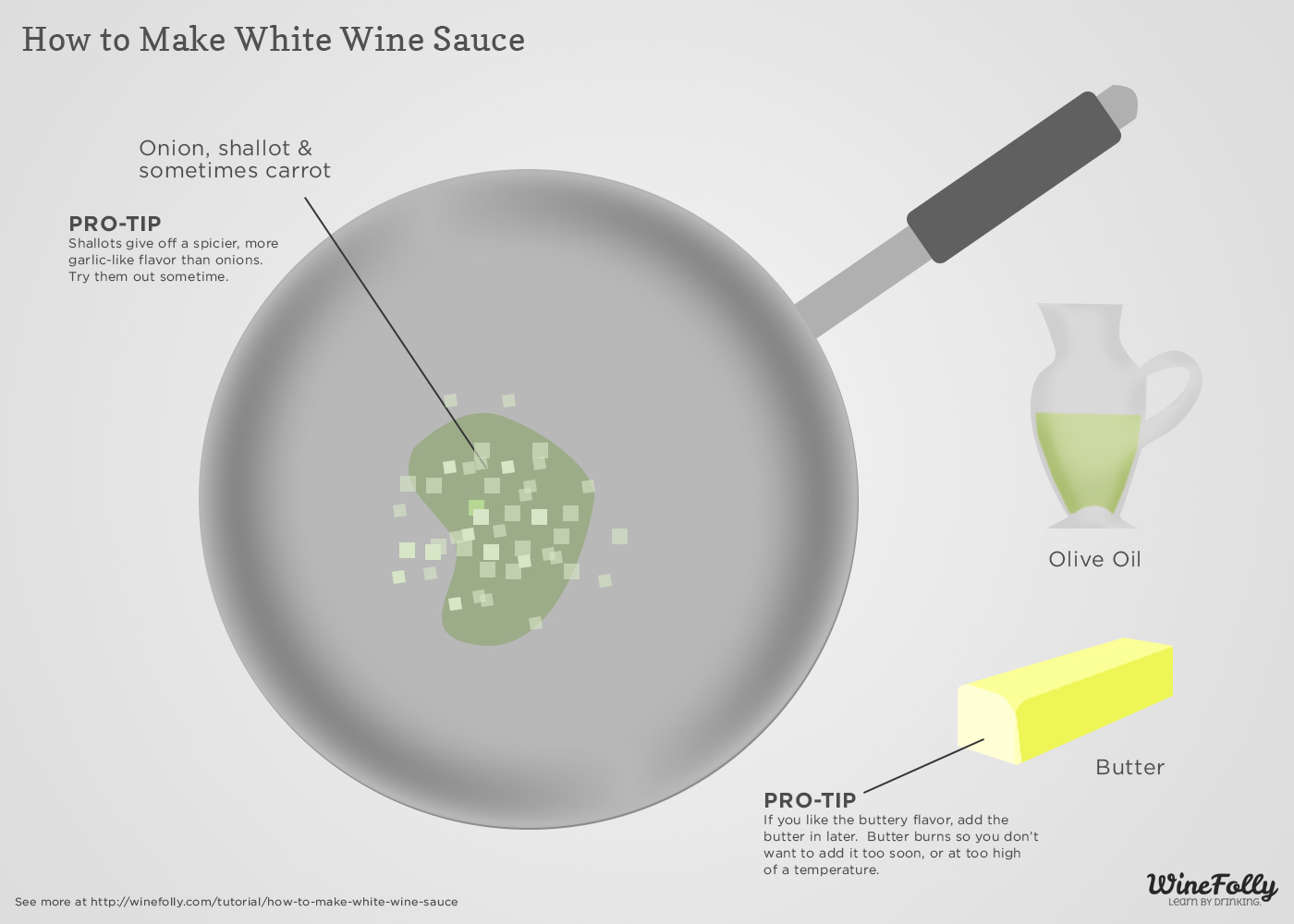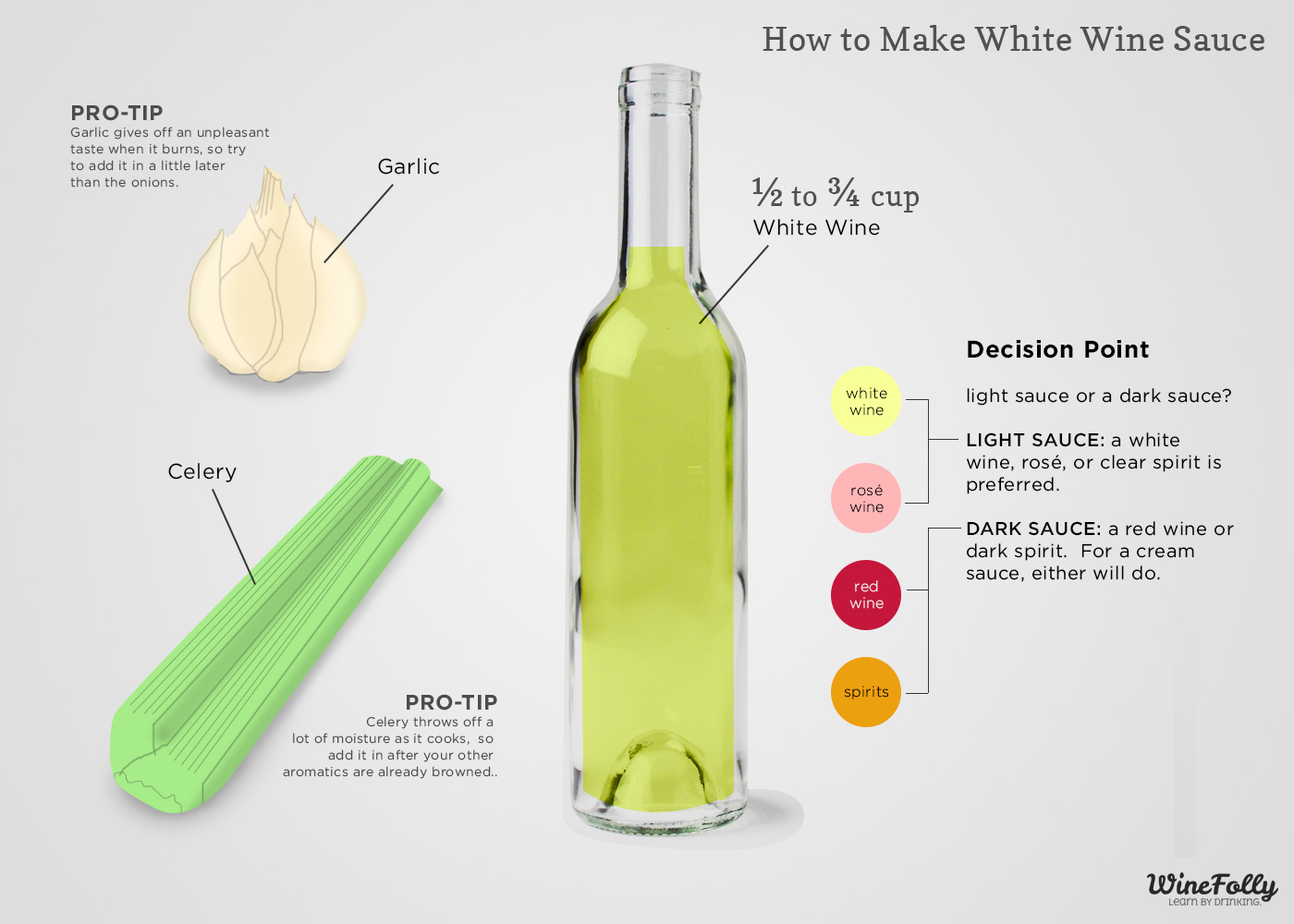Think more like a chef and make the best white wine sauce through understanding how ingredients work.
My mother always told me I relied too much on recipes, and it’s true. Food people love finding exotic recipes and executing them in home kitchens. Nevertheless, I always marveled at her ability to take a bottle of wine and whatever was in her pantry at the time and produce amazing food.
Who really needs recipes anyway?
In the end, she was right. If you search online for white wine sauce recipes for chicken, or bourbon sauce for ribs, or marsala for veal, or red wine sauce for pork chops; they are all virtually the same. So, why not learn the fundamentals instead? Who really needs recipes anyway?
Understanding The Components of a Dish
The Starch
This is typically pasta, rice or potato in various forms. In this primer we will focus on a sauced-based method for preparing a dish. So, for the starch, you want to prepare it any way you see fit but slightly undercooked. You will add it into the sauce to finish it.
The Protein
In addition to chicken, fish, pork and red meat; tofu or other meat substitutes can go well here. Go ahead and prepare this however you like, the same as you did with the starches.
For our sauce method the best idea would be to cook the meat (or at least brown it) in the saucepan, then set it aside slightly undercooked. You will thenadd this into the sauce to finish it.
The Veggies
There are a base set of veggies that will be a part of the sauce-making process. For other types of vegetables, depending on the “toughness” of their consistency, there will be different times during the sauce-making process to add them. For fresh and leafy vegetables, you want to add them at the very end to preserve their freshness.
Chef’s Method: White Wine Sauce Recipe
Here is a versatile primer you can use to make many different kinds of dishes with a wine or spirit sauce that ties in all the components.
You’ll find this method can be used to make some French, Italian and other Mediterranean-style dishes. It won’t make you every sauce out there, but if you’re looking for a good foundation with endless possibilities, this is the primer for you!
This primer will produce enough sauce for 3-4 servings. Simply double all measurements to make 6-8 servings.
STEP 1
Get your pan going
Heat a skillet or saucepan on medium high. Once it is hot, add about a tablespoon of olive oil, followed by ¼ to ⅓ cup of diced onions or shallots (you can also add ½ to ⅔ cup carrots at this point).
For the fullest flavor, prepare this sauce in the same pan you used to cook your protein without cleaning or scraping.
The leftover rendered fat and flavors from your protein are essential to a good sauce. If you prepared in a different pan, add as much as you can to this pan to start.
By the way, “drippings” are the rendered fat and leftover pieces of cooked meat in a pan. You want to use this as a flavor base for any sauce you make.
Pro Tips
- If you want a buttery flavor, add your butter in later. Butter burns easily so don’t add it too soon or at too high of a temperature.
- Shallots give off a spicier, more garlic-like flavor than onions. Try them sometime! Bourdain will smile upon you.
STEP 2
Get your pan smelling good
Once the onions are starting to give off moisture but not browned, add about 1-2 cloves of diced garlic. After the other aromatics start to brown you can add in ⅓ to ⅔ cup celery if you choose.
By the way, “aromatics” are vegetables that give off deep, well-rounded flavors. French aromatics are called mirepoix (pronounced “meer-pwah”) which is one part chopped onions per two parts celery and carrots. Italian aromatics are called soffritto (pronounced “soh-FREE-toh”) and always include chopped onions and garlic.
Speaking of terminology, “sweat” is the term used to describe what onions look like in the pan after they’ve been heated but before they brown.
Pro Tips
- Garlic gives off an unpleasant taste when it burns, so try to add it a little later than the onions.
- Celery throws off a lot of moisture as it cooks, so try to add it in after your other aromatics are already browned.
STEP 3
Wine Time! Pour yourself a glass…
Once all aromatics have browned, pour ½ to ¾ cup wine or spirit of your choice into the pan. Use your spatula to scrape the bottom of the pan thoroughly. See the attached visual to help choose which wine or spirit to use at this point.
In general, this is the point at which you decide whether you want a light sauce or a dark sauce.
For a light sauce, a white wine, rose or clear spirit is preferred. For a dark sauce use a red wine or dark spirit. For a cream sauce, either will do.
In case you didn’t know, “deglazing” is the process of using wine, stock or other liquid to clean and scrape the bottom of the pan during the cooking process.
Pro Tips
- Using a red wine in a cream sauce will result in a final product that is pink.
- For a more pronounced flavor, add a tablespoon of wine or spirit vinegar. For instance, Champagne vinegar in white wine sauce.
STEP 4
Decision time: what are you? Italian? French?
Once the volume of the sauce has reduced by at least half, add another tablespoon or more of a fat or oil of your choice. Once incorporated, whisk in at least one tablespoon of flour.
If you are going for a French flavor, butter is a good choice for the fat at this point – Italian flavor uses more olive oil. You may need to adjust the amount of fat/oil and flour based on how thick you want your sauce to be.
Keep in mind the thickness will change based on decisions made in future steps. The end result will also thicken as the sauce cools.
STEP 5
Herbs!
This is a step you may decide to skip. If you are using fresh herbs in your sauce, add half of them now. This will ensure the flavor incorporates well. The herbs you add now will not maintain their freshness, so you’ll be adding the other half later. The total amount of fresh herbs you add can be between 1 tablespoon and ¼ of a cup.
Pro Tips
For dry herbs, it doesn’t matter much when you add them. They need some time to incorporate into the sauce, but not much. Add them near the end of the process so you can adjust to taste. Their flavor in the sauce will become stronger as the sauce sits.
STEP 6
Volumnize! Cream-a-size!
At this point you can add volume to your sauce. If you are going for a very reduced, concentrated sauce then skip this step.
Otherwise, add between ½ and 1 cup of liquid for volume. What kind of liquid are we talking about here? Well, you can use different types of broth, milk or cream.
For a cream sauce, add ½ to 1 cup of heavy whipping cream or milk. If adding milk, you will want to reduce the sauce for as much as 15 minutes.
For a light sauce, add ½ to 1 cup of chicken stock. For a dark sauce, add ½ to 1 cup of beef broth. For a light sauce with a fish, you can even add a fish stock.
Incorporation Point: If you choose pasta as your starch, you want to incorporate it at this point. Just dump it in the pan, mix it around and finish the rest of the steps. Some people elect to serve their pasta and sauce separately, but why?
The key here is the incorporation of flavors. If you plan on reducing your stock or milk for a long time, add this in mid-step 7. You don’t want to overcook your pasta.
By they way, “Béchamel” is the name of the French base for all cream sauces. The process is similar to what is outlined in this primer with two exceptions. In a proper béchamel the milk is reduced separately and incorporated afterward with a “roux” (pronounced “roo” – reduced butter and flour).
In a béchamel, the aromatics are also strained off.
Speaking of cooking terms, “al dente” is an Italian term used to describe ideal pasta done-ness. You want it firm, but not hard.
Slimy, overcooked pasta is awful. Err on the side of caution and undercook your pasta. You can always simmer it in the sauce a little longer to get it just right.
Pro Tips
- For that Béchamel-style flavor add some nutmeg, like the French would.
- Sauces are very forgiving. In the end you can always add more of any ingredient until you get the flavor and consistency you like.
- If you are cooking with fresh pasta, it will cook fast. Add it in near the end of step 7, it only needs a few minutes to cook.
STEP 7
Everyone loves a little cheese.
After adding your cream or broth, lower the temperature to a medium-low heat and allow the sauce to simmer for 5 to 15 minutes, depending on how reduced you would like the sauce to be.
Want to add cheese? If you are making a cheese sauce, this is the point to add the cheese. Depending on how strong the cheese is you should add between ¼ and 1 cup of cheese. Some cheeses worth trying are parmigiano reggiano (¼ to ½ cut grated), parmesan (1 cup) or gorgonzola (¼ to ½ cup). Ask your local cheesemonger for tips on what cheeses work well in sauces.
Incorporation Point: Take the meat you have prepared and mix it in with the sauce at this point. If you have slightly undercooked it, finish it off by allowing it to simmer in the pan with the sauce for a few minutes.
By the way, “Afredo sauce” is a common term for an Italian-style Parmigiano Reggiano creamy cheese sauce. Parmesan cheese is a US made imitation of Italian Parmigiano Reggiano, both of which you can find in your local supermarket.
STEP 8
Finishing touches.
Time to season and correct. Start with ¼ tsp of salt and a ¼ tsp of pepper. Taste it. It should be flavorful and have a slight kick. If it is bland, add a little more salt. At this point you can be creative, try some different herbs and spices! Try to keep it simple and don’t overdo it. If you are using fresh herbs, now would be the time to incorporate the other half.
Incorporation Point: At this point you can mix in your rice if that was your starch of choice, unless you choose to leave it separate. Same with your potatoes.
If you are adding at this point you probably didn’t want to undercook either of them. If you want to add them earlier, you can add at the same point as the pasta, although this takes some practice. It can easily turn into a mushy mess.
Pro Tips
Learn to correct by understanding what flavors cancel one another out. Too salty? Add some volume, acid, fat or sweetness. Too spicy? Add some fat. Too bland? Add some salt. Sauces are very forgiving, you’ll just end up with more sauce. Need some acid? Add a little lemon juice. Need some sweetness? Try molasses or honey.


